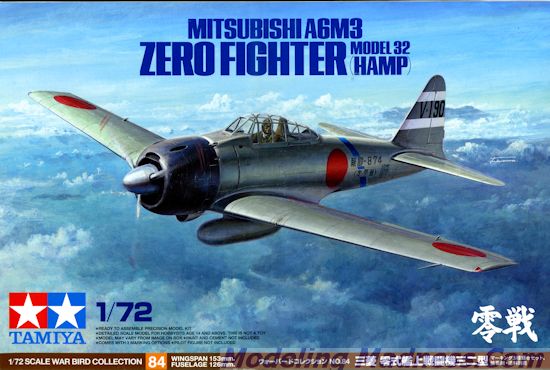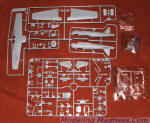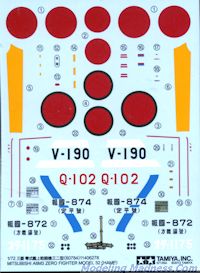
| KIT #: | 60784 |
| PRICE: | $1,120 yen (about $11.00) from Hobby Link Japan. SRP is 1400 yen. |
| DECALS: | Three options |
| REVIEWER: | Scott Van Aken |
| NOTES: |

| HISTORY |
In late 1941, Nakajima introduced the Sakae 21, which used a two-speed supercharger for better altitude performance, and increased power to 840 kW (1,130 hp). Plans were made to introduce the new engine into the Zero as soon as possible.
The new Sakae was slightly heavier and somewhat longer due to the larger supercharger, which moved the center of gravity too far forward on the existing airframe. To correct for this the engine mountings were cut down by 20 cm (8 in), moving the engine back towards the cockpit. This had the side effect of reducing the size of the main fuel tank (located to the rear of the engine) from 518 L (137 US gal) to 470 L (120 US gal).
The only other major changes were to the wings, which were simplified by removing the Model 21's folding tips. This changed the appearance enough to prompt the US to designate it with a new code name, Hap. This name was short-lived, as a protest from USAAF commander General Henry "Hap" Arnold forced a change to "Hamp". Soon after, it was realized that it was simply a new model of the "Zeke". The wings also included larger ammunition boxes, allowing for 100 rounds for each of the 20 mm cannon.
The wing changes had much greater effects on performance than expected. The smaller size led to better roll, and their lower drag allowed the diving speed to be increased to 670 km/h (420 mph). On the downside, maneuverability was reduced, and range suffered due to both decreased lift and the smaller fuel tank. Pilots complained about both. The shorter range proved a significant limitation during the Solomons campaign of 1942 during which land-based Zeros from Truk airbase had to travel significant distances to the combat zones over Guadalcanal.
The first Model 32 deliveries began in April 1942, but it remained on the lines only for a short time, with a run of 343 being built.
| THE KIT |
 This
is the fourth 1/72 Zero produced by Tamiya in their new mold group. It is not
the first time Tamiya has done a 1/72 A6M3 type 32, as one was in their initial
1/72 kit releases back in the 1960s. However, this one is far more detailed, as
one would expect from Tamiya. There are two major sprues with Tamiya's finely
engraved detailing and quite a few small parts. Another tiny sprue holds the
cowling, there is a nice clear sprue and a pair of poly inserts.
This
is the fourth 1/72 Zero produced by Tamiya in their new mold group. It is not
the first time Tamiya has done a 1/72 A6M3 type 32, as one was in their initial
1/72 kit releases back in the 1960s. However, this one is far more detailed, as
one would expect from Tamiya. There are two major sprues with Tamiya's finely
engraved detailing and quite a few small parts. Another tiny sprue holds the
cowling, there is a nice clear sprue and a pair of poly inserts.
The two sprues presented are an A and E sprue with the clear bits being the B sprue. All of the sprues are separately bagged including the cowling which was cut from the E sprue. What is different from the earlier A6M2 kit is the replacement of the D sprue with the E sprue. This latter sprue has far fewer bits on it than the earlier one.
The detail in the cockpit is worthy of a 1/32 kit with a goodly number of small boxes. While there is also a decal for the main instrument panel, you will need to break out the 10/0 brush for the others. There are the usual inserts for the lower intake, just like Hasegawa. The only option is for an open or closed canopy. The kit provides two of them, one for those who wish to model the aircraft with the canopy closed and the other with a separate sliding canopy section. A drop tank is also included. Engine detail is nicely done for this scale as well.
 Markings are for three
aircraft. Two of them are in the overall Ame-iroe color of early war planes.
V-190 is from Tainan Air Group based at Buna in New Guinea during 1942. Second
is Q-102, also based at Buna, but with the 2nd Air Group. These are both
presentation aircraft and their markings have been done before. The third option
is from the Oita Naval Air Group and is in dark green over the Ame-iro. This
plane has the white in the roundels painted out. It is also the only plane to
use the yellow wing leading edge ID stripes, which are provided as decals. A
nice touch is that Tamiya provides the three point harness as a decal.
Markings are for three
aircraft. Two of them are in the overall Ame-iroe color of early war planes.
V-190 is from Tainan Air Group based at Buna in New Guinea during 1942. Second
is Q-102, also based at Buna, but with the 2nd Air Group. These are both
presentation aircraft and their markings have been done before. The third option
is from the Oita Naval Air Group and is in dark green over the Ame-iro. This
plane has the white in the roundels painted out. It is also the only plane to
use the yellow wing leading edge ID stripes, which are provided as decals. A
nice touch is that Tamiya provides the three point harness as a decal.
| CONCLUSIONS |
If you were happy with the Hasegawa A6M series, then you will be more pleased with these, if for no other reason that the more detailed cockpit. Of course, it will cost a bit more, but it is well worth it.
| REFERENCE |
http://en.wikipedia.org/wiki/Mitsubishi_A6M_Zero
September 2014
Thanks to Hobby Link Japan for the preview kit. Get yours today at this link.
If you would like your product reviewed fairly and fairly quickly, please contact the editor or see other details in the Note to Contributors.